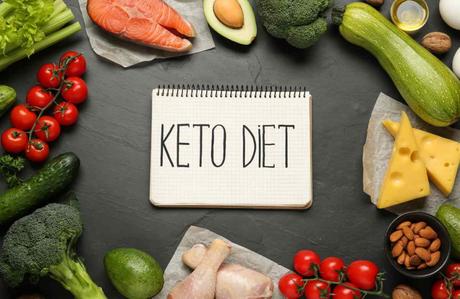Wondering if the keto diet is working for you? Here are nine classic signs and symptoms that you are in ketosis.

The keto diet has exploded in popularity in recent years, due to how effective it is for losing weight and improving overall health.
Short for “ketogenic,” the keto is diet low in carbohydrates, and high in fats and protein.
Instead of using carbs for energy, the body synthesizes ketones1, which target fat for fuel, resulting in some serious fat burning.
While the benefits of keto are extensive (fat burning, weight loss, better brain health, etc.), it’s not always clear that you are in ketosis.
Not to worry, though.
In this article, we will look at how you can be crystal-clear about whether or not you are in ketosis.
Let’s jump right in.
Ketosis – A Quick Overview
Now that we know what keto is, how is it used to lose weight?
As mentioned, rather than using carbs for fuel, this diet utilizes fat.
The longer your body uses fat for energy instead of glucose/carbohydrates, the more efficient it becomes at doing so.
When in ketosis, glycogen stores and quite a bit of water are also lost (which is part of why proper hydration during keto is so important).
Not only that, but it can help suppress appetite and sugar cravings, leading those on keto to consume fewer calories.
Combine it all, and you have a system designed for burning fat like it owes you money!
So, how do you actually know you’re in ketosis?
Here are 9 common signs – both positive and negative – that will help clear things up.
9 Signs and Symptoms You Are in Ketosis
Alrighty, let’s get right into it.
Here are nine big clues that you and ketosis have snuggled up as BFF’s:
1. You’ve got bad breath (seriously).
Okay, this probably isn’t a symptom you’re looking to purposefully achieve.
However, it’s one of the first and most common side effects of entering ketosis.
Many people on Keto report their breath smelling sweet or fruity2.
This is due to the elevated ketone levels in the body, specifically acetone. Acetone is a ketone that already exists in our urine and breath, but can cause bad breath when it becomes more concentrated.
While this symptom typically improves over time, there are ways to help mask it.
Chewing on sugar-free gum or brushing teeth more often throughout the day.
Additionally, drinking water infused with peppermint or spearmint is also effective and won’t put you at risk of spiking your blood sugar.
2. Decrease in Physical Performance
When you’re first starting Keto, it’s not uncommon to feel drained of energy or experience general lethargy.
There’s no need to be concerned if you feel this way, as this is a typical reaction when your body switches over from carbs to fat for energy.
Have you ever had a candy bar or bottle of Coke and felt a jolt of energy afterward?
This is because carbohydrates supply you with a faster source of fuel than fat does.

While your body is acclimating to this change in mechanics, you’ll typically feel sluggish and fatigued.
In fact, studies found that athletes on Keto that performance dips, with reduced energy at first. But no worries… in those same studies, performance did return after a little bit of time.
How long it takes to acclimatize varies from person to person, but generally within a week or two on the diet, you should notice your energy levels increase.
3. Digestive Issues
This is a very common symptom when starting Keto, as you’re likely making a drastic change to your diet.
Carbohydrates often contain a lot of fiber, such as oatmeal, brown rice, etc.
Once you take those out, you’ll need to replace them with low-carb foods that contain a good amount of fiber.
Here are a few:
- Spinach
- Avocados
- Almonds
- Lentils
- Edamame
- Blackberries
- Asparagus
- Flaxseeds
It’s also crucial to drink enough water and get enough electrolytes to stay hydrated.
You may want to consider taking a probiotic as well, as they can help to balance gut bacteria as your body gets used to this new diet (See also: BioFit Probiotics — Full Review).
4. Weight Loss
The big symptom that most people are looking for as they embark on this specific diet is feeling a little lighter on their toes via weight loss.
There is plenty of studies3 that show keto’s effectiveness for overall weight loss, so it would stand to reason that you are in keto as the numbers on the scale start to creep downwards.
Not only that, but you’ll be losing a good amount of water weight.
Looking for a meal planning tool for keeping you on track with the keto diet? Check out my full review of Keto Custom Diet. It’s a customized program that gives you a 14-day diet plan specific to your needs and tastes.
With less carbohydrates to hold energy, your body burns through them, getting rid of all the water they hold.
In the first week or so of beginning Keto, you’ll notice a “whoosh effect” because of this.
You can expect to lose anywhere from 2 to 7 pounds (more or less) of water weight during this time.
5. Insomnia or waking up intermittently
One of the not-so-awesome symptoms of ketosis, particularly at the beginning when your body is getting used to the carb elimination, is difficulty sleeping.
It can be common to experience insomnia or waking up intermittently throughout the night when you first reduce your intake of carbs.
It’s also attributed to lower levels of serotonin and melatonin, which can keep you from drifting off to sleep.
Carbs boost tryptophan levels in our brains, which convert to serotonin, helping us produce the sleep hormone, melatonin.
See also: 6 Reasons You’re Not Losing Weight on Keto
However, this is also a temporary symptom and should resolve itself in a matter of weeks.
And by no means is this a guaranteed symptom.
Research with participants in three weeks of ketosis found no negative impacts on sleep and mood compared to a high-carbohydrate control group5.
6. Reduced Appetite
There are many benefits of the keto diet, and this is undoubtedly one of them!
Reduced appetite happens for an array of different reasons while in ketosis.
First, it’s been suggested that the process of ketosis itself can lower hunger levels6.
In addition, protein is more satiating than carbohydrates, resulting in longer-lasting feelings of fullness.
When glucose levels spike, the body tries to regulate it by bringing it down.
This can often make blood sugar crash by bringing it too far down, causing hunger pangs or inducing sugar cravings.
In contrast, when you limit carb intake, blood glucose spikes are quite rare.
7. Keto Flu
While the keto flu isn’t the same for everyone, it tends to present many similarities to your average flu.
Aside from fatigue and digestive issues, you could experience:
- Nausea
- Foggy brain
- Headaches
- Irritability
- Decreased exercise performance
…and other symptoms.
While no one is completely sure what causes the keto flu (no official studies have undertaken to find out), the effects tend to pass after 2-7 days.
Navigating the keto flu and its symptoms can be made easier by drinking lots of water, eating more frequently to avoid nausea (easier said than done, I know!), using a natural sleep aid, or even trying some of the best keto pills on the market, specifically designed to accelerate you into ketosis.
8. Muscle Cramps/Spasms
If you’ve had a really bad cramp before, you may have had someone tell you to eat a banana.
This is because bananas are relatively high in potassium.
Muscle cramps are often caused by dehydration or an imbalance in electrolytes (potassium, magnesium, sodium).
When your body is still acclimating to the Keto Diet, you may lose more water and electrolytes than normal.
This is in response to lower levels of insulin and glucose.
Cramping (or at least the worst of it) should subside within the first few days of transitioning to Keto.
Aside from cramping and spasms, it’s crucial that you remain well-hydrated.
You can do this in a variety of ways, such as drinking electrolyte water, drinking broth-based soups, and more.
Additionally, keto pills like Keto Charge have ketones like sodium Beta-Hydroxybutyrate that can help elevate mineral and electrolyte levels in the blood7.
9. Increased Ketone Levels
This is probably the most obvious and certain way to know if you’re in ketosis: measuring blood ketone levels.
There are keto test strips that test your saliva or urine for ketones, but they’ve proven to be less accurate than blood tests.
To measure your ketone levels, these blood test meters calculate the quantity of beta-hydroxybutyrate (BHB) in your blood.
If your results range from 0.5 to 3.0 mmol/L, you’re considered to be in “nutritional ketosis”.
That’s what you want!
Blood testing kits can be expensive, however, so if you decide to purchase one you may not want to test more than once a week.
Alternatively, you can go to your doctor and ask them to perform a ketone blood test on you.
Signs & Symptoms of Ketosis — FAQs
What are the first signs of ketosis?
Aside from bad breath, you could experience either diarrhea or constipation.
Headaches, irritation, and feeling tired is also very common as you’re changing the source of energy your body has become accustomed to for a very long time.
Despite feeling fatigued, you could have a hard time falling asleep as well. It’s okay if you don’t feel like going to the gym these first few days, but being active can help avoid muscle cramps.
Dropping a few pounds within the first week is very common, so don’t feel concerned if this happens.
It’s completely normal.
Just make sure you’re staying hydrated and getting enough rest.
How long does it take to get into ketosis?
This amount of time varies a little bit for everyone.
It depends on your body, age, your hormones, your metabolism, and how many grams of carbs you’re consuming.
Also consider the percentage of fats and protein you’re consuming.
If you aren’t eating enough fat, or eating too much protein, you could experience gluconeogenesis.
This is where your body produces glucose due to eating too much protein.
This can slow down fat loss, and potentially bump you out of ketosis.
If you’re consuming fewer than 50 grams of carbs a day, you can expect it to take approximately 2 to 4 days.
For some people it could take a week, or even a bit longer.
The Bottom Line
The benefits of Keto are immense, and it makes sense why it’s become so popular.
However, when you’re first starting out, it can be confusing to know whether or not you’re in ketosis.
By listening to your body and following these tips, you’ll be able to take full advantage of the keto diet and be on your way to accomplishing all of your weight loss and wellness goals.
More Keto Guides and Resources
What are Keto Pills? (And Do They Actually Work?). Keto pills promise to help you get into ketosis more easily. But do they? Here’s a look at the pros and cons and what the research has to say.
6 Best Keto Cookbooks for Mastering the Ketogenic Diet. The right keto cookbook can give you clarity and the recipes to keep your tastebuds happy and your weight loss goals on track. Here’s a review of the best keto cookbooks on shelves right now.
